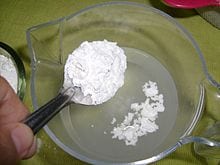Contents
It is a white, tasteless powder that is familiar to many of us. It is found in wheat and rice grains, beans, potato tuber, and the cob of corn. However, in addition to these products, we find starch in boiled sausage, ketchup and, of course, in all kinds of jelly. Depending on their origin, starch grains vary in shape and particle size. When the starch powder is squeezed in the hand, it emits a characteristic creak.
Starch-rich foods:
Indicated approximate quantity in 100 g of product
General characteristics of starch
Starch is absolutely insoluble in cold water. However, under the influence of hot water, it swells and turns into a paste. While studying at school, we were taught that if you drop a drop of iodine on a piece of bread, the bread will turn blue. This is due to the specific reaction of starch. In the presence of iodine, it forms the so-called blue amyliodine.
By the way, the first part of the word – “amyl”, indicates that starch is a slimy compound and consists of amylose and amylopectin. As for the formation of starch, it owes its origin to the chloroplasts of cereals, to potatoes, as well as to a plant that is called maize in its homeland, in Mexico, and we all know it as corn.
It should be noted that, in terms of its chemical structure, starch is a polysaccharide, which, under the influence of gastric juice, is capable of being converted into glucose.
Daily starch requirement
As mentioned above, under the influence of acid, starch is hydrolyzed and converted into glucose, which is the main source of energy for our body. Therefore, in order to feel good, a person must definitely eat a certain amount of starch.
You just need to eat cereals, bakery and pasta, legumes (peas, beans, lentils), potatoes and corn. It is also good to add at least a small amount of bran to your food! According to medical indications, the body’s daily need for starch is 330-450 grams.
The need for starch increases:
Since starch is a complex carbohydrate, its use is justified if a person has to work for a long time, during which there is no possibility of frequent meals. Starch, gradually transforming under the influence of gastric juice, releases glucose necessary for full life.
The need for starch is reduced:
- with various liver diseases associated with impaired breakdown and assimilation of carbohydrates;
- with low physical exertion. In this case, starch is able to be converted into fat, which is deposited “pro-stock”
- in the case of work requiring an immediate supply of energy. Starch is converted into glucose only after some time.
Starch digestibility
Due to the fact that starch is a complex polysaccharide, which, under the influence of acids, can be completely converted into glucose, the digestibility of starch is equal to the digestibility of glucose.
Useful properties of starch and its effect on the body
Since starch is able to convert into glucose, its effect on the body is similar to glucose. Due to the fact that it is absorbed more slowly, the feeling of satiety from the use of starchy foods is higher than with the direct use of sweet foods. At the same time, the load on the pancreas is much less, which has a beneficial effect on the health of the body.
Interaction of starch with other essential elements
Starch interacts well with substances such as warm water and gastric juice. In this case, water makes the starch grains swell, and hydrochloric acid, which is part of the gastric juice, turns it into sweet glucose.
Signs of a lack of starch in the body
- weakness;
- fatigue;
- frequent depression;
- low immunity;
- decreased sexual desire.
Signs of excess starch in the body:
- frequent headaches;
- overweight;
- low immunity;
- irritability;
- small bowel problems;
- constipation
Starch and health
Like any other carbohydrate, starch should be strictly regulated. Do not consume excessive amounts of starchy substances, as this can lead to the formation of fecal stones. However, you should not avoid the use of starch either, because in addition to a source of energy, it forms a protective film between the wall of the stomach and gastric juice.
We have collected the most important points about starch in this illustration and we would be grateful if you share the picture on a social network or blog, with a link to this page:










